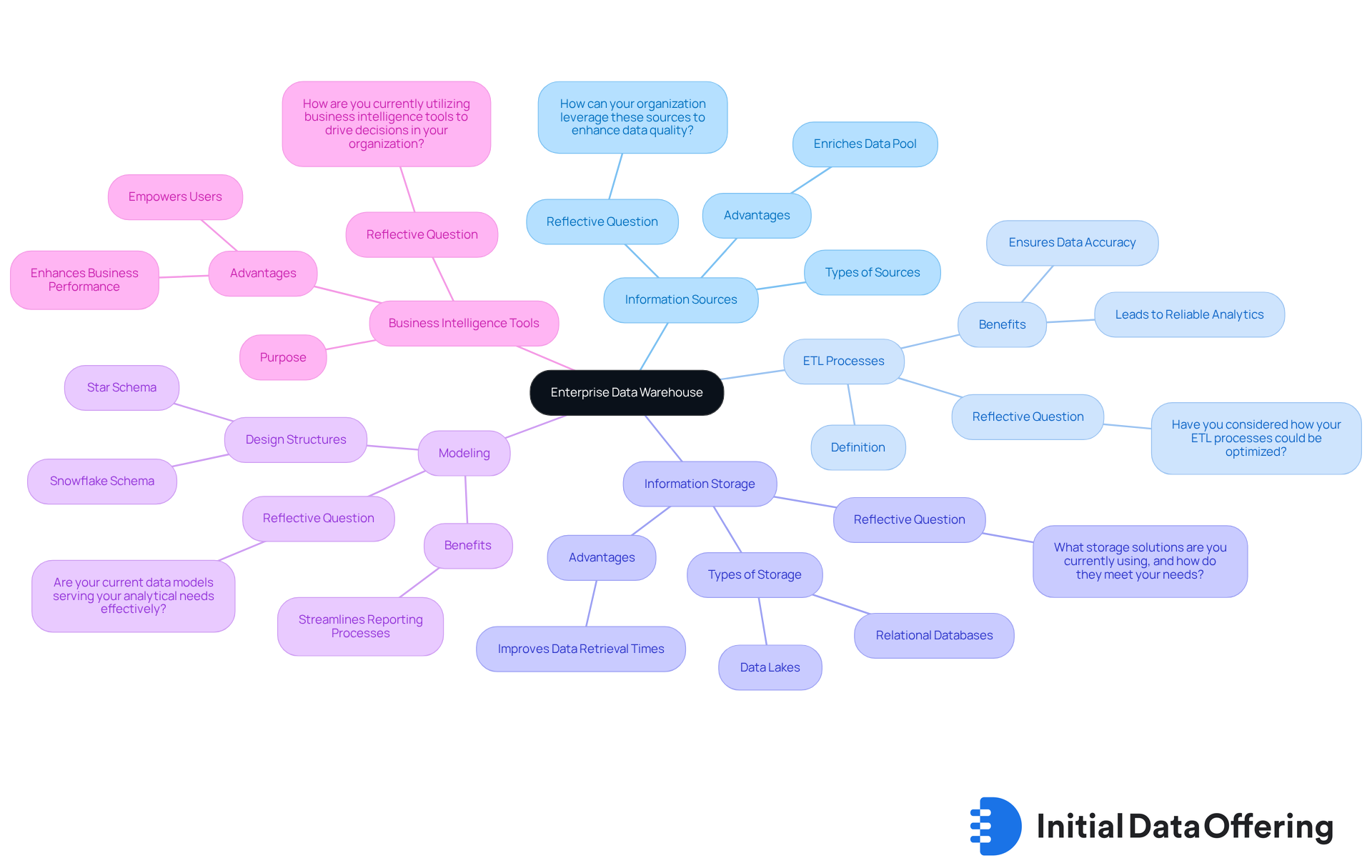Understanding the Enterprise Data Warehouse Definition and Its Importance

Understanding the Enterprise Data Warehouse Definition and Its Importance
Overview
An enterprise data warehouse (EDW) serves as a centralized repository that integrates data from various sources, playing a pivotal role in supporting business intelligence activities. What does this mean for organizations? The EDW's ability to provide a unified view of organizational data enhances decision-making and operational efficiency. This integration not only streamlines data management but also empowers businesses to respond swiftly to market changes.
The advantages of utilizing an EDW are significant. By consolidating data, organizations can achieve a comprehensive understanding of their operations, leading to informed strategic planning. This capability is crucial in today’s fast-paced business environment, where agility and responsiveness are key to maintaining a competitive edge.
Ultimately, the benefits of an EDW extend beyond mere data storage. It transforms how businesses analyze and utilize information, fostering a culture of data-driven decision-making. As companies increasingly rely on accurate data insights, the EDW emerges as an essential asset for modern enterprises. How can your organization leverage an EDW to enhance its operations? Consider the implications of adopting such a system and the potential for improved efficiency and strategic foresight.
Introduction
The enterprise data warehouse (EDW) serves as a cornerstone of modern business intelligence. It offers a centralized repository that integrates diverse data sources, empowering organizations in their decision-making processes. By providing a unified perspective on information, an EDW enhances operational efficiency and fosters a culture of data-driven strategies.
However, as companies navigate the complexities of data management, a crucial question arises: how can organizations fully leverage the capabilities of an EDW? Understanding this can unlock deeper insights and help maintain a competitive edge in an ever-evolving market.
To fully appreciate the value of an EDW, consider its features. It consolidates data from various sources, ensuring that all relevant information is accessible in one place. This integration not only streamlines operations but also supports informed decision-making. The advantages are clear: organizations can respond more swiftly to market changes and make strategic choices based on comprehensive data analysis.
Ultimately, the benefits of utilizing an EDW extend beyond mere efficiency. They include enhanced collaboration across departments and improved customer insights, which can lead to better service and increased satisfaction. As you reflect on your organization’s data management strategies, consider how an EDW could transform your approach and drive success.
Define Enterprise Data Warehouse
The enterprise data warehouse definition highlights its role as a centralized repository that integrates information from various sources, specifically designed to support business intelligence (BI) activities, reporting, and analysis.
Features: Unlike conventional databases that focus on specific applications, an EDW consolidates data across the entire organization. This integration provides a comprehensive view of business operations, allowing users to access a single source of truth for their informational needs.
Advantages: By offering a unified perspective, an EDW facilitates more informed decision-making and strategic planning. Users can analyze data from different departments seamlessly, leading to insights that might otherwise remain hidden in siloed systems.
Benefits: Ultimately, the use of an EDW empowers organizations to enhance their operational efficiency and responsiveness to market changes. How might your organization benefit from having a centralized data repository? Consider the potential for improved collaboration and data-driven strategies.
In summary, the enterprise data warehouse definition illustrates how an EDW not only streamlines data management but also fosters a culture of informed decision-making, making it an invaluable asset for any organization aiming to thrive in today’s data-driven landscape.

Trace the Evolution of Enterprise Data Warehousing
The enterprise data warehouse definition emerged in the late 1980s as businesses recognized the need for a centralized repository to improve decision-making processes. Initially, these repositories focused primarily on historical analysis. However, with advancements in technology, their functionalities evolved significantly.
The introduction of online analytical processing (OLAP) in the 1990s marked a pivotal moment, enabling users to perform more complex queries and retrieve information more swiftly. This shift not only improved efficiency but also allowed organizations to derive deeper insights from their data.
As we moved into the 2000s, the rise of large-scale information systems and cloud computing transformed the enterprise data warehouse definition. Companies could now manage vast amounts of data and expand their storage solutions effectively. This evolution has led to the contemporary enterprise data warehouse definition that incorporates real-time information processing and advanced analytics.
Why is this important? Today, organizations that leverage these capabilities can gain a competitive edge by utilizing insights derived from their data. By understanding the evolution of information warehousing, businesses can better appreciate its role in driving informed decision-making and strategic planning.

Identify Key Components of an Enterprise Data Warehouse
Understanding the enterprise data warehouse definition is crucial for identifying the key components necessary for effective data management and decision-making.
-
Information Sources: These include various internal and external sources, such as transactional databases, CRM systems, and third-party information feeds. They supply essential data into the warehouse, ensuring a comprehensive view of organizational information. The advantage of having diverse sources is that it enriches the data pool, leading to more informed insights. How can your organization leverage these sources to enhance data quality?
-
ETL processes, which are defined as Extract, Transform, Load (ETL) procedures, play a vital role in cleaning, transforming, and loading information into the enterprise data warehouse definition. This ensures that the data is not only accurate but also consistent across the board. The benefit here is that high-quality data, as outlined in the enterprise data warehouse definition, leads to reliable analytics, which is critical for strategic decision-making. Have you considered how your ETL processes could be optimized?
-
Information Storage: The physical retention of information can be organized, like relational databases, or unorganized, such as data lakes. This flexibility allows organizations to choose storage solutions that best fit their needs. The advantage of tailored storage is that it can significantly improve data retrieval times and efficiency. What storage solutions are you currently using, and how do they meet your needs?
-
Modeling: This involves designing structures that facilitate efficient querying and reporting, often utilizing star or snowflake schemas. Effective modeling enhances the ability to analyze data quickly and accurately. The benefit is that it streamlines reporting processes, making it easier for stakeholders to access insights. Are your current data models serving your analytical needs effectively?
-
Business Intelligence Tools: These applications enable users to analyze and visualize information, facilitating insights and informed decision-making. The advantage of using these tools is that they empower users to derive actionable insights from data, enhancing overall business performance. How are you currently utilizing business intelligence tools to drive decisions in your organization?

Examine Benefits of Enterprise Data Warehousing
Establishing an enterprise data warehouse definition offers several compelling advantages that can significantly enhance organizational performance.
-
Enhanced Information Quality: One of the primary features of an EIW is its centralized information management. This ensures consistency and precision across data sets, effectively reducing errors and discrepancies. By maintaining high-quality information, organizations can trust the data they rely on for decision-making.
-
Improved Decision-Making: With access to extensive and current information, companies can make knowledgeable choices rapidly. This advantage allows businesses to respond swiftly to market changes and internal challenges, fostering a proactive approach to management.
-
Enhanced Efficiency: Streamlined information processes minimize the time spent on data retrieval and reporting. This efficiency allows teams to focus more on analysis rather than management, ultimately driving productivity. How much time could your team save by optimizing these processes?
-
Scalability: Modern data warehouses are designed to expand seamlessly, accommodating increasing data volumes. This scalability ensures that organizations can adapt to evolving business requirements without compromising performance.
-
Advanced Analytics: EIWs support sophisticated analytical tools and techniques. This feature enables organizations to uncover insights that drive innovation and competitive advantage. What insights could your organization gain from advanced analytics?
In summary, the establishment of an enterprise data warehouse definition not only enhances information quality but also improves decision-making, boosts efficiency, provides scalability, and supports advanced analytics. These benefits collectively empower organizations to thrive in a data-driven landscape.

Conclusion
The essence of an enterprise data warehouse (EDW) is its role as a centralized hub for integrating diverse data sources, which is essential for informed business intelligence and strategic decision-making. By transforming fragmented information into a cohesive resource, an EDW becomes an invaluable tool for organizations aiming to enhance operational efficiency and responsiveness.
Key components of an EDW include:
- The importance of diverse information sources
- Effective ETL processes
- Tailored storage solutions
- Efficient data modeling
- The use of business intelligence tools
Each of these elements is crucial for ensuring high-quality data management, enabling organizations to derive actionable insights and make timely decisions. How can your organization leverage these components to improve its data strategy?
Ultimately, embracing the capabilities of an enterprise data warehouse not only elevates the quality of information but also fosters a culture of data-driven decision-making. Organizations should assess their current data management strategies and consider the transformative potential of implementing an EDW. In a landscape increasingly governed by data, leveraging such a system can provide a significant competitive advantage, driving innovation and success.
Frequently Asked Questions
What is an enterprise data warehouse (EDW)?
An enterprise data warehouse is a centralized repository that integrates information from various sources, specifically designed to support business intelligence (BI) activities, reporting, and analysis.
How does an EDW differ from conventional databases?
Unlike conventional databases that focus on specific applications, an EDW consolidates data across the entire organization, providing a comprehensive view of business operations.
What are the advantages of using an EDW?
The advantages of using an EDW include facilitating more informed decision-making and strategic planning by allowing users to analyze data from different departments seamlessly.
What benefits does an EDW provide to organizations?
An EDW empowers organizations to enhance their operational efficiency and responsiveness to market changes, leading to improved collaboration and data-driven strategies.
Why is an EDW considered an invaluable asset for organizations?
An EDW streamlines data management and fosters a culture of informed decision-making, making it crucial for organizations aiming to thrive in today’s data-driven landscape.